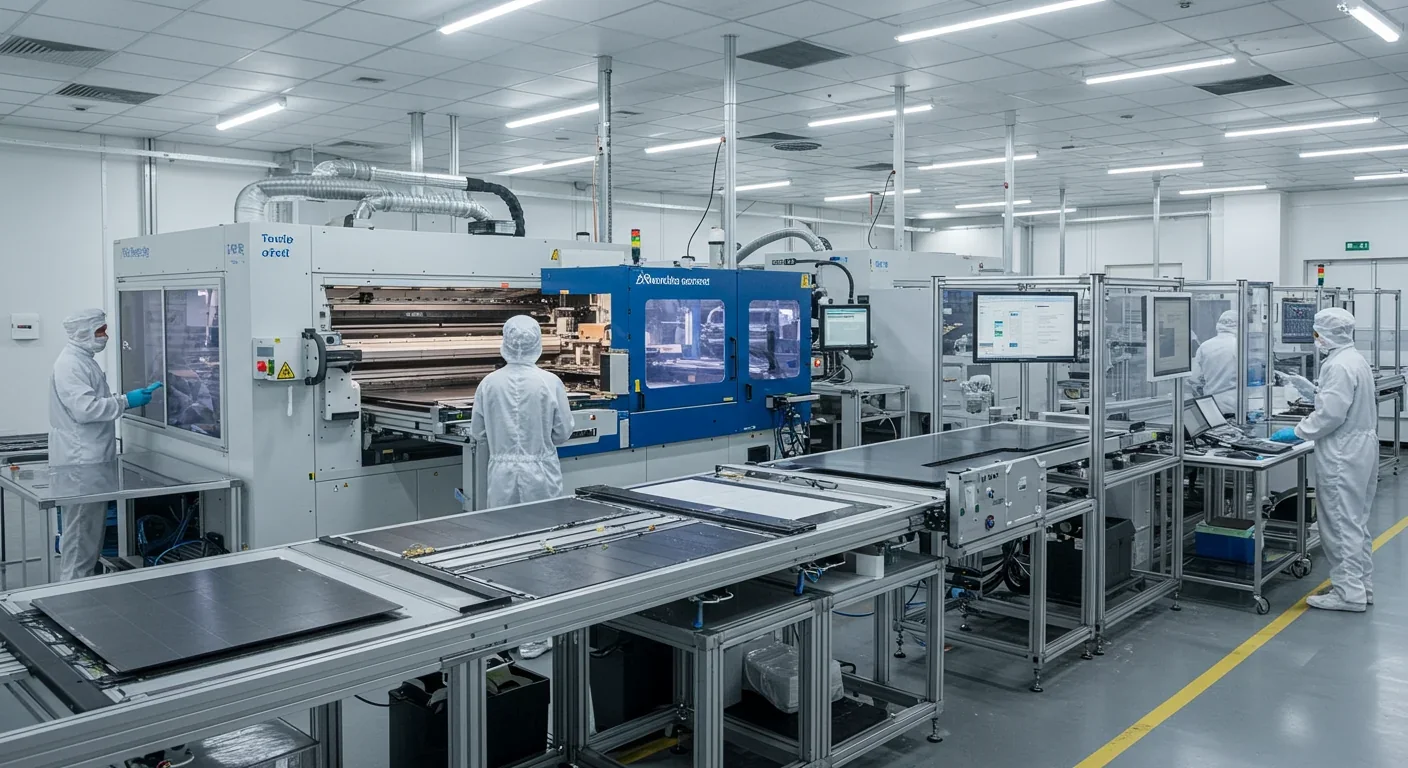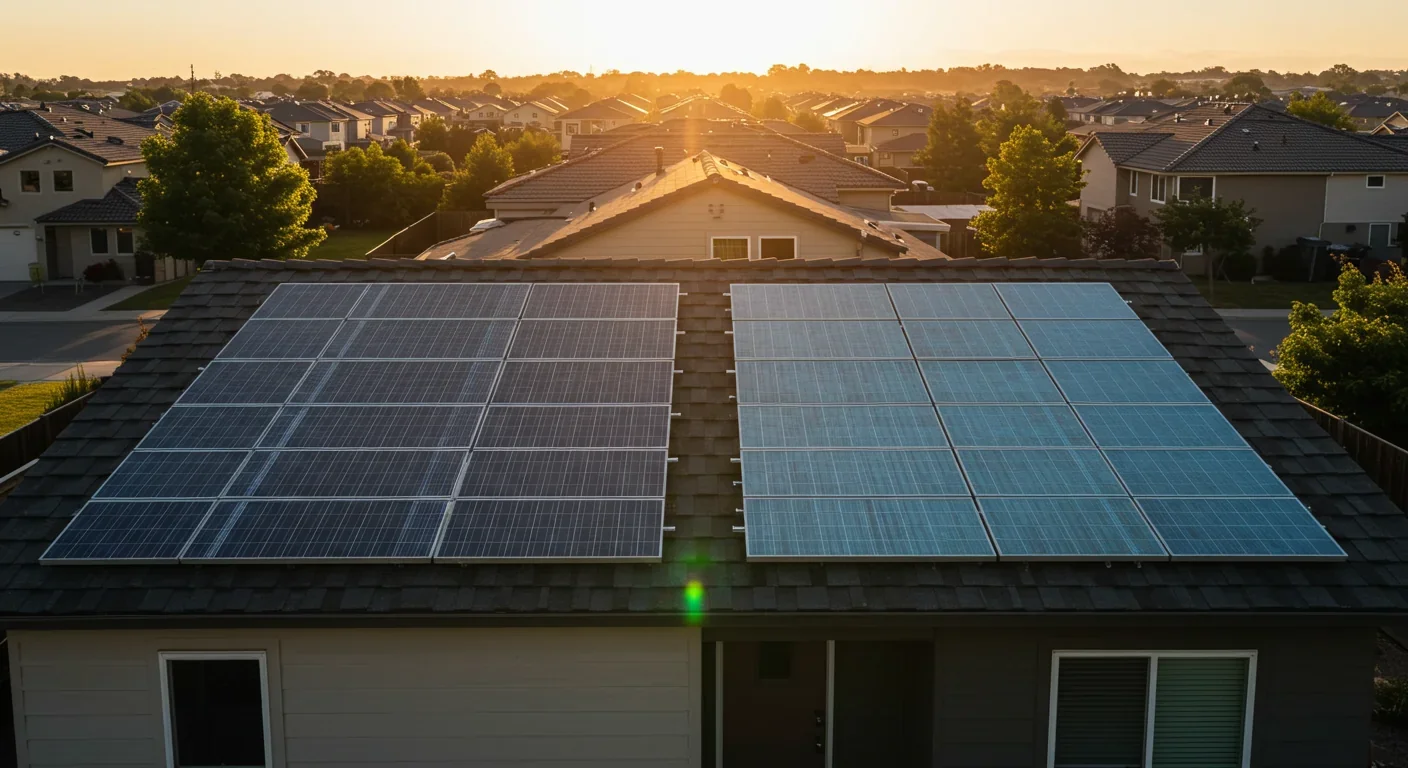Underground Air Storage: Renewable Energy's Hidden Battery

TL;DR: Perovskite solar cells have reached efficiency levels matching silicon while promising 30-50% lower costs. Despite stability challenges, recent breakthroughs extend lifespans to years, bringing paint-on solar technology within 3-5 years of commercial reality.

By 2030, the solar panels on your roof might not look like panels at all. They could be painted on like house paint, flexible enough to wrap around curved surfaces, and cheaper than anything currently available. This isn't science fiction—it's the promise of perovskite solar cells, a technology that's been quietly achieving breakthroughs in labs worldwide and is now on the verge of commercial reality.
The energy landscape is shifting beneath our feet. While traditional silicon solar panels have dominated for decades, perovskite solar cells are emerging as a revolutionary alternative that could democratize renewable energy access in ways we've only imagined. The numbers tell a compelling story: these cells have reached 26.1% efficiency in labs, matching silicon's best performance. When combined with silicon in tandem cells, they've hit a staggering 34.6% efficiency—numbers that were considered impossible just a few years ago.
At the heart of this revolution is a material with an unusual name and even more unusual properties. Perovskites are crystal structures named after Russian mineralogist Lev Perovski, but what makes them special isn't their history—it's their atomic arrangement. The formula ABX₃ describes how these crystals organize themselves, creating a structure that's remarkably good at converting sunlight into electricity.
Traditional silicon solar panels require pure crystalline silicon, grown in energy-intensive processes at temperatures exceeding 1,400°C. Perovskite cells, by contrast, can be manufactured at room temperature using solution processing—essentially printing or spray-coating the material onto surfaces. This fundamental difference cascades through every aspect of production, from cost to flexibility to application possibilities.
The science is elegant. When photons hit a perovskite layer, they excite electrons in the material's crystal lattice. These energized electrons create a current that can be captured and used. What makes perovskites special is how efficiently they absorb light across the visible spectrum and how easily those excited electrons can move through the material before recombining.
Perovskite cells can be manufactured at room temperature using printing techniques—a radical departure from silicon's energy-intensive, high-temperature production that requires specialized facilities.

A decade ago, perovskite solar cells barely registered on efficiency charts. In 2009, they converted about 3.8% of sunlight into electricity—interesting but impractical. Then something remarkable happened. Researchers began tweaking the crystal composition, adjusting the ratios of methylammonium, lead, and halides. Efficiency jumped to 10%, then 15%, then kept climbing.
The progress wasn't just incremental; it was exponential. Silicon solar technology took 40 years to reach 20% efficiency. Perovskites did it in about six years. By 2025, single-junction perovskite cells have matched silicon's laboratory efficiency of 26.1%, according to data from the National Renewable Energy Laboratory. But the real breakthrough came with tandem cells.
Tandem solar cells stack different materials to capture different wavelengths of light. Silicon is excellent at converting red and infrared light, while perovskites excel at blue and green wavelengths. By layering them, researchers have created cells that recently achieved 34.6% efficiency—and some triple-junction designs are pushing even higher. New world records keep falling, with some configurations reaching over 31% efficiency.
This matters because every percentage point of efficiency translates directly into more power from the same surface area. A typical home with 30 square meters of roof space could generate 20-30% more electricity with these advanced cells compared to conventional panels.
"Silicon solar technology took 40 years to reach 20% efficiency. Perovskites did it in about six years."
— National Renewable Energy Laboratory data analysis
The cost story is where perovskite cells become truly transformative. Manufacturing perovskite solar cells requires far less energy and fewer materials than silicon panels. The active perovskite layer is measured in nanometers—about 100 times thinner than human hair. Silicon wafers, by contrast, are hundreds of micrometers thick and require expensive purification and crystal-growing processes.
Solution processing changes the manufacturing equation completely. Instead of multi-billion-dollar fabrication facilities, perovskite cells can potentially be manufactured using printing techniques similar to newspaper production. The chemicals involved—methylammonium iodide, lead halides—are inexpensive and abundant. Early estimates suggest perovskite panels could cost 30-50% less than silicon to produce at scale.
This cost advantage cascades through the entire solar installation. Lighter, more flexible panels reduce structural requirements for rooftop installations. The ability to print cells on various substrates opens possibilities for building-integrated photovoltaics—windows, walls, even vehicle surfaces—without the weight and rigidity constraints of glass-encased silicon.
Several companies are betting billions on this potential. Oxford PV, a UK spinout, has demonstrated production-ready tandem cells. In China, companies like Microquanta and GCL are scaling up manufacturing, with China leading global perovskite commercialization efforts. The global perovskite solar cell market, valued at around $1.8 billion in 2024, is projected to explode to over $9 billion by 2033, growing at a compound annual rate exceeding 40%.

Here's where the story gets complicated. Perovskite solar cells have one critical weakness: they're fragile. Traditional silicon panels come with 25-year warranties because they're remarkably stable. Encased in glass and aluminum, they withstand decades of sun, rain, and temperature swings with minimal degradation.
Perovskite cells, however, are sensitive to moisture, oxygen, heat, and even ultraviolet light—all of which are abundantly present where solar panels need to work. Early perovskite cells degraded within hours when exposed to humid air. The crystal structure that makes them so efficient at converting light also makes them vulnerable to environmental breakdown.
Moisture infiltration causes the most immediate damage. Water molecules disrupt the crystal lattice, breaking the carefully arranged atomic structure. Oxygen exposure creates a slower but equally destructive process, oxidizing the organic components and lead halides. Heat accelerates both processes, and the thermal cycling that panels experience daily—heating up in sunlight, cooling at night—stresses the material further.
For years, this stability problem seemed insurmountable. Industry analysts questioned whether perovskites would ever transition from laboratory curiosities to commercial products. Some researchers suggested the technology might always remain too fragile for real-world deployment.
Then the breakthroughs started coming.
Early perovskite cells degraded within hours when exposed to humid air. Recent breakthroughs have extended operational lifetimes beyond 2,100 hours in accelerated tests—equivalent to several years of real-world use.
Scientists at the University of Surrey made a discovery that could change everything: embedding aluminum oxide nanoparticles within the perovskite layer dramatically extends operational lifespan. The nanoparticles act as moisture barriers and structural reinforcement, preventing the cascade of degradation that previously doomed these cells.
Other approaches are showing similar promise. Research teams have developed new molecular additives and surface treatments that protect perovskite crystals from environmental damage. Some groups are experimenting with 2D perovskite layers as protective caps over 3D active layers. Others are exploring entirely new crystal compositions that maintain high efficiency while being inherently more stable.
Precision spray coating techniques have improved uniformity, reducing defects that serve as starting points for degradation. Better encapsulation methods—borrowing techniques from OLED display manufacturing—seal cells more effectively against moisture and oxygen infiltration.
The results are encouraging. Some recent perovskite cells have demonstrated operational lifetimes exceeding 2,100 hours under accelerated aging tests, equivalent to several years of real-world use. While that's still far short of silicon's decades-long lifespan, the trajectory is promising. Testing protocols are being standardized, allowing researchers to compare results and identify the most promising approaches.
The stability challenge isn't solved, but it's no longer considered insurmountable. Multiple research pathways are converging on practical solutions. The question has shifted from "if" to "when."

The flexibility of perovskite cells enables applications that silicon panels can't touch. Solar paint is no longer a futuristic fantasy—it's a serious research focus. Mercedes-Benz has explored using perovskite technology for automotive applications, envisioning cars with power-generating paint that could extend electric vehicle range.
Building-integrated photovoltaics represent an enormous market opportunity. Instead of mounting panels on roofs, architects could incorporate power generation into the building envelope itself. Perovskite cells can be made semi-transparent, creating windows that generate electricity while still allowing light through. This transforms every skyscraper facade into a potential power plant.
The portability possibilities are equally exciting. Flexible perovskite cells could power wearable electronics, creating truly energy-independent devices. Disaster relief organizations could deploy rollable solar arrays that pack into backpacks. Military applications—where weight and portability are critical—are driving significant research investment.
Curved surfaces that can't accommodate rigid silicon panels become viable locations for power generation. Stadium roofs, vehicle surfaces, boat hulls, even clothing could incorporate thin, flexible perovskite cells. The material's light weight—about 100 times lighter than traditional panels—eliminates structural constraints that limit where solar can be installed.
Space applications offer another frontier. The light weight and high efficiency of perovskite cells make them attractive for satellites and spacecraft, where every gram matters. Early radiation testing suggests perovskites may actually perform better than silicon in the harsh radiation environment of space.
"Mercedes-Benz is exploring power-generating paint for electric vehicles—a practical application that could extend EV range without adding weight or aerodynamic drag."
— Perovskite-Info industry report
Not everything about perovskites is cause for celebration. The most efficient formulations contain lead, raising legitimate environmental and health concerns. Lead is highly toxic, and while the amounts in solar cells are relatively small, widespread deployment could create new contamination pathways if panels break or are improperly disposed of.
Researchers are working on lead-free alternatives using tin, bismuth, or other elements, but so far these haven't matched the efficiency of lead-based cells. Tin-based perovskites suffer from even faster degradation. Double perovskites using combinations of elements show promise but require more research.
Encapsulation offers a partial solution. Properly sealed cells contain the lead, preventing release under normal conditions. Some manufacturers are developing self-healing encapsulants that can repair minor damage before it leads to material escape. Recycling protocols are being designed to recover lead and other materials when panels reach end-of-life.
The lifecycle analysis is still being refined, but early indications suggest perovskite cells could have a smaller environmental footprint than silicon panels when manufacturing energy, materials, and transportation are considered. The lower energy intensity of production and lighter weight for shipping partially offset the lead concerns.
Regulation will play a crucial role. Standards for encapsulation, labeling, and disposal need to be established before large-scale deployment. The solar industry successfully manages other hazardous materials—cadmium telluride panels contain toxic cadmium but are deployed safely at utility scale. Similar frameworks could work for perovskites.

A geopolitical competition is unfolding over perovskite technology. China has emerged as the leader in commercialization, leveraging its dominance in solar manufacturing and willingness to invest in scaling new technologies before they're fully mature. Companies like Microquanta and LONGi have announced plans for gigawatt-scale perovskite production.
Europe is positioning itself as the innovation hub, with companies like Oxford PV demonstrating some of the highest efficiency tandem cells. The European Union is funding research consortia to maintain technological leadership, even as manufacturing shifts east. The Perovskite-Connect conferences are becoming crucial gathering points for the industry, defining standards and fostering collaboration.
The United States, despite inventing many foundational perovskite technologies, is playing catch-up in commercialization. Federal research funding through NREL and ARPA-E supports continued innovation, but scaling manufacturing requires private investment and policy support that has been inconsistent. Some U.S. startups are focusing on niche applications—space, defense, building integration—rather than competing directly in the utility-scale panel market where Chinese manufacturers have cost advantages.
The patent landscape is complex. Thousands of patents cover different perovskite compositions, manufacturing processes, and applications. This fragmentation could either enable widespread innovation through licensing or create barriers that slow deployment through legal battles. Industry groups are working to establish patent pools and standards that allow broad adoption while rewarding innovators.
Developing nations stand to benefit enormously if perovskite costs fall as projected. Countries across Africa, Southeast Asia, and Latin America could leapfrog centralized grid infrastructure by deploying distributed solar generation. The lower cost and simpler manufacturing could enable domestic production, creating jobs and energy independence simultaneously.
Developing nations could leapfrog traditional grid infrastructure entirely, deploying distributed perovskite solar generation the same way they bypassed landline phones for mobile networks.
Commercial perovskite products are already arriving, but the timeline for widespread adoption depends on which applications you're considering. Several manufacturers are now selling perovskite panels or modules in limited quantities, primarily to early adopters and commercial pilots.
Oxford PV's tandem cells are in production, with first commercial installations happening in Europe. The company claims these panels will offer 20% more power than conventional silicon panels in the same footprint. Initial production runs are small—enough to prove the technology works at scale but not yet enough to impact global markets.
For residential consumers, realistic availability is probably 3-5 years away. That timeline accounts for proving long-term durability, establishing supply chains, training installers, and building consumer confidence. Early products will likely carry premium prices, justified by higher efficiency rather than lower costs. The cost advantages will materialize as production scales.
Utility-scale deployment could happen faster in some markets. China's aggressive commercialization push could see gigawatt installations within 2-3 years, especially for tandem cells that maximize power output on limited land area. Developing markets might adopt perovskite technology even faster if simpler, cheaper single-junction cells reach the market first.
Building-integrated applications face longer timelines because they require coordination with construction industries and building codes. Perovskite windows and facades might become available for new construction within five years, but retrofitting existing buildings will take longer.
The paint-on solar vision remains further out—perhaps 7-10 years. True solar paint requires solving significant engineering challenges beyond just efficiency and stability. The coatings need to be easy to apply, durable under weathering, connectable to electrical systems, and safe for non-professionals to use. These aren't insurmountable obstacles, but they're not trivial either.
Solar adoption often surprises forecasters with its speed once it crosses tipping points. In 2000, experts predicted it would take decades for solar to become cost-competitive with fossil fuels. By 2020, solar was the cheapest source of new electricity generation in most of the world. The cost curve bent faster than almost anyone anticipated because of compounding factors: manufacturing scale, technological improvements, supply chain efficiency, and policy support all reinforced each other.
Perovskites could follow a similar trajectory, but with key differences. Unlike silicon solar, which required developing entirely new supply chains, perovskites can leverage existing manufacturing infrastructure from related industries—display manufacturing, printing, chemical processing. This could accelerate scaling.
The incumbent silicon industry won't disappear, but it's adapting. Many major silicon manufacturers are investing in tandem cell technology, planning to add perovskite layers to their existing silicon production lines. This hybrid approach could dominate the next generation of solar technology, combining silicon's proven durability with perovskite's efficiency gains.
Previous energy transitions took 50-70 years from invention to dominance. The transition from whale oil to kerosene, from kerosene to electricity, from coal to natural gas—all followed similar S-curves spanning decades. But the pace of technology adoption has accelerated. Smartphones went from introduction to global ubiquity in about 15 years. Renewable energy is following a similarly compressed timeline.
The solar revolution isn't just about technology—it's about economics and access. Silicon panels made solar viable for wealthy nations and large companies. Perovskites promise to make solar accessible to billions more people. That's a fundamentally different kind of transformation.

Preparing for a perovskite-enabled energy future requires thinking beyond just the technology. Electrical grids designed for centralized power plants struggle with distributed generation from millions of solar installations. Grid modernization—smart meters, dynamic pricing, improved storage, advanced forecasting—becomes essential infrastructure.
Workforce development is crucial. Solar installation is already one of the fastest-growing job categories in many countries. Adding perovskite technology will require training technicians in new skills: handling sensitive materials, proper encapsulation, quality testing. The paint-on applications will blur the line between electricians and painters, creating entirely new specializations.
Policy frameworks need updating. Building codes, electrical standards, safety regulations, and disposal requirements were all written for silicon panels. Perovskite cells, especially flexible and semi-transparent variants, don't fit existing categories. Forward-thinking regulators are already engaging with manufacturers to develop appropriate standards that ensure safety without stifling innovation.
Investment patterns are shifting. Venture capital is flowing into perovskite startups, with some companies raising hundreds of millions to scale production. But public research funding remains essential for solving fundamental challenges around stability and lead-free alternatives. The most successful energy transitions have combined private innovation with public support for basic research.
For individuals, the implications extend beyond simply buying new solar panels. As distributed generation becomes cheaper and more accessible, decisions about energy independence become more compelling. Combining perovskite solar with battery storage could make grid defection economically rational for millions of households. That shift would ripple through utility business models, real estate values, and energy policy.
The most profound impact of perovskite solar cells might be psychological. For decades, renewable energy was framed as a sacrifice—more expensive, less reliable, requiring subsidies and political will to adopt. Silicon solar began changing that narrative, making clean energy economically attractive. Perovskites could complete the transformation, making solar not just competitive but superior: cheaper, more versatile, easier to deploy.
This changes the climate conversation fundamentally. Instead of asking people to accept lower living standards or higher costs to reduce emissions, we can offer a future with more energy, more cheaply, with less environmental impact. That's a much easier sell politically and economically.
The technology isn't perfect yet. Stability challenges remain. Manufacturing needs to scale. Supply chains must be established. Regulatory frameworks require development. But the trajectory is clear. Perovskite solar cells have progressed in 15 years from laboratory curiosity to commercial reality. The next 5-10 years will determine whether they become the dominant form of solar technology.
What started as academic research into unusual crystal structures has become one of the most promising paths to addressing climate change while expanding energy access globally. The solar panels of 2035 will likely look nothing like today's glass rectangles. They might be painted on, integrated into windows, wrapped around curves, or applied to surfaces we haven't even considered yet.
The revolution won't happen overnight, but it's undeniably underway. And unlike previous energy transitions that took generations, this one is unfolding fast enough that most people reading this will see it transform the world around them. The question isn't whether perovskite solar cells will change our energy future. It's how quickly we can harness their potential to build a cleaner, more abundant energy system for everyone.

Lunar mass drivers—electromagnetic catapults that launch cargo from the Moon without fuel—could slash space transportation costs from thousands to under $100 per kilogram. This technology would enable affordable space construction, fuel depots, and deep space missions using lunar materials, potentially operational by the 2040s.

Ancient microorganisms called archaea inhabit your gut and perform unique metabolic functions that bacteria cannot, including methane production that enhances nutrient extraction. These primordial partners may influence longevity and offer new therapeutic targets.

CAES stores excess renewable energy by compressing air in underground caverns, then releases it through turbines during peak demand. New advanced adiabatic systems achieve 70%+ efficiency, making this decades-old technology suddenly competitive for long-duration grid storage.

Human children evolved to be raised by multiple caregivers—grandparents, siblings, and community members—not just two parents. Research shows alloparenting reduces parental burnout, improves child development, and is the biological norm across cultures.

Soft corals have weaponized their symbiotic algae to produce potent chemical defenses, creating compounds with revolutionary pharmaceutical potential while reshaping our understanding of marine ecosystems facing climate change.

Generation Z is the first cohort to come of age amid a polycrisis - interconnected global failures spanning climate, economy, democracy, and health. This cascading reality is fundamentally reshaping how young people think, plan their lives, and organize for change.

Zero-trust security eliminates implicit network trust by requiring continuous verification of every access request. Organizations are rapidly adopting this architecture to address cloud computing, remote work, and sophisticated threats that rendered perimeter defenses obsolete.